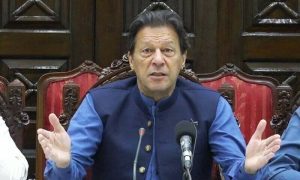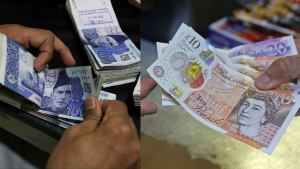
[ad_1]

China bails the country out (with more loans) approximately four times in six months.
Despite having little in common, even our political parties could agree on one thing: Pakistan’s economic situation was dire in 2023. The year saw Pakistan go through a long and rocky road to finding some semblance of economic stability — if it can even be called that — while weathering political and social turmoil. Pakistanis also experienced a double whammy this year: the one-two punches of the worst economic crisis in decades and all-time high inflation. Add to that the gut punch of the aftermath of the catastrophic floods of 2022 began to settle in.
In 2023, according to the World Bank, over 39.4 per cent of the population fell below the poverty line, which means over 12.5 million people are living in meagre conditions. Additionally, 8.5 million people face acute food insecurity due to high inflation and the balance of payments crisis, effectively making the country one of the worst in terms of food security on the Global Hunger Index.
Those who could leave just up and left the country. Several of my close friends moved abroad too because of the uncertainty. They were not alone. More than 450,000 people left Pakistan in the first three months of 2023 because of a lack of employment opportunities and the consensus that Pakistan was on the brink of default.
A default, according to Faisal Mamsa, the chief executive of Tresmark, is the culmination of a series of events. The primary cause is that outflows of cash are consistently more than inflows, and you need to borrow to fund that mismatch.
The risk of Pakistan’s defaulting reared its ugly head throughout the year, enough to drain the optimism out of the best of us. According to the US Institute of Peace, Pakistan owes its creditors over 77.5 billion dollars in the next three years.
The debt servicing to government revenues ratio has inflated to a point which has left a big, red question mark on the nation’s economic future.
An almost dystopian picture was painted especially by citizens on X when they thought of Pakistan actually defaulting, perhaps even worse than Sri Lanka’s economic crisis the previous year. A person on X pointed out that the state could lose its legitimacy if Pakistan truly ran out of basic imports. Another pointed out that a state of lawlessness would ensue if Pakistan went through a default, which let’s face it, the country is no stranger to.
Consequently, even the harshest critics of the International Monetary Fund (IMF) agreed that it was necessary for Pakistan to safely navigate its default risks.
When talking about the IMF, economic liberals such as Miftah Ismail paint a rosy picture of the institution, as they talk about adhering to its conditions, words such as ‘privatisation’ and ‘trade liberalisation’ are presented as answers to Pakistan’s challenges.
While the Dars of our time built up the notion that the dollar can be controlled through artificial means. But even they were forced to put their pride aside to assuage the Bretton Woods institution.
Putting those who claim to be economic oracles aside, it does ring alarm bells when you think about the country having to constantly battle the risk of default for the better part of the year amid political upheaval with political members more concerned with slinging mud at one another than with the average man’s plight.
With elections around the corner, let’s take a journey — a very bitter and hard-to-digest one — at the number of times Pakistan has come close to default this year.
January
In January, the dwindling foreign reserves raised alarm bells, even to those who did not pay attention to the economy, as it reached $4.6 billion — barely enough to cover three weeks’ worth of imports.
Inflationary pressure was building and the State Bank was forced to raise its monetary policy rate to 17pc to rein in high inflation, taking the country’s key policy rate to its highest level since 1997.
Dread over default rose as Pakistan failed to placate the IMF due to differences. Funding from other multilateral and bilateral institutions also got jammed, raising questions of how the country will meet its external finances of over $30bn which include energy imports and debt financing.
February
Pakistan’s economic crisis reached its boiling point in February as the rupee underwent its biggest devaluation in history — of 15pc. This exacerbated fears that Pakistan was heading towards a default without a comprehensive IMF programme to prop it up.
The State Bank’s foreign exchange reserves shrunk to a meagre $3.7bn, which wasn’t enough to last a month’s import bill.
Pakistan and IMF held virtual talks in hopes of unlocking the $1.1bn tranche as part of a $6.5bn bailout signed in 2019 to no avail. The delay in talks also made government bond prices plummet.
However, China stepped in with a life-saving $700m loan, effectively becoming Pakistan’s biggest creditor.
By the end of February, Moody’s — a credit rating agency in the US — downgraded Pakistan’s credit rating to Caa3, citing Pakistan’s dismal liquidity raising the risk of default as Pakistan continued to fail to negotiate with the IMF. It further added that it saw no clear visibility of Pakistan’s future funding needs apart from the IMF, and warned that “weak governance and heightened social risks impede Pakistan’s ability to continually implement the range of policies that would secure large amounts of financing”.
March
In March, China came to the rescue again, providing respite to the country with a $2bn loan as Pakistan’s negotiations with the IMF stalled; its dire balance-of-payments crisis continued despite the government removing artificial caps on the exchange rate and raising fuel prices to meet IMF requirements.
Moreover, inflation in the country hit a record 50-year-high at over 30pc. It got worse.
April
Inflation hit another historic record at 36.4pc as Pakistan’s acute balance of payments crisis continued in April. This time, Saudi Arabia stepped in with some relief as it pledged over $2bn to help finance Pakistan’s essential imports.
Saudi Arabia’s role was deemed an important step to unlocking the $1.1bn tranche from the IMF, as one of the lender’s requirements was for Pakistan to provide financing assurances from bilateral creditors.
May
The IMF was brought to the negotiating table once again to conclude the ninth review of its programme, as the sword of default continued to hang above Pakistan.
The IMF, quickly raised the issue of fiscal reforms and measures to straighten Pakistan’s fiscal structure so it could improve its finances.
June
Pakistan’s risk of default continued as the question of how it would go on about its debt servicing went unanswered, with central bank reserves hovering around $3bn. Hopes were minimal as IMF talks continued.
The IMF raised concerns over a new tax amnesty in the federal government’s budget as it was against the institution’s conditions and governance agenda.
The government then responded by increasing taxes, slashing subsidies and stopping artificial control of the rupee.
And just when things were getting worrisome on the import side, China came to the rescue yet again with the roll over of $1bn as the gruelling negotiations with the IMF continued.
July
In July, Pakistan rejoiced at securing the $3bn dollars staff-level arrangement, however, the country still hovers on the edge of default as reserves remain dismally low. The road to unlocking the tranche remains full of obstacles as Pakistan waits for IMF orders and adheres to its conditionality, which includes difficult decisions of increasing taxes and cutting subsidies, in addition to letting the rupee freefall against the dollar.
Subsequently, the rupee continues its depreciation against the dollar by 1.34pc in July.
In addition, China coame to rescue yet again with $600m in financing as the country anxiously waits for the tranche release by the IMF. This brings China’s loans to the country to around $5bn in three months just to help Pakistan avoid default.
August
Inflation remained sky-high at 27.4pc in August as the government sought to meet IMF conditions, making it all the more difficult to focus on inflationary pressure and rupee depreciation.
Additionally, the rupee depreciated around 6.2pc against the greenback in a month.
September
Against the backdrop of the administrative clampdown against the black currency market, the rupee improved its standing against the dollar, as stakeholders held their breath for the IMF review.
According to a Bloomberg report, the rupee becomes the best performing currency in September, appreciating by more than 6pc.
November – default averted?
In November, the IMF review concluded successfully, unlocking a better-than-expected $700m out of the $1.1bn tranche of the ninth month package, as agreed in July. The IMF stressed on a market-oriented currency rate and warns of rising geopolitical tensions in the near future. Everyone breathed a sigh of relief.
Current scenario
Accordingly, Khurram Schehzad, chief executive of Alpha Beta Core, emphasised on Pakistan’s economic scenario being inextricably linked with global geopolitics.
He stated that even though commodity prices have adjusted downwards, continuity of wars such as the Russian invasion of Ukraine and Palestinian question will continue to keep a check on commodity prices, and therefore will continue to pose threat to Pakistan external account as it is an import-based economy.
Yousuf M. Farooq, director of research at Chase Securities, observed that the global market had considerably tightened, making it a challenge to finance deficits and roll over debt with higher interest rates.
Additionally, he noted that small current account surpluses were imperative to halt the accumulation of debt and demonstrate to creditors the country’s commitment to resolving its issues; in particular there is a need for “continued fiscal consolidation”.
Tahir Abbas, head of research at Arif Habib Limited, noted that the economic situation of Pakistan has improved significantly post signing of the IMF Stand-By Arrangement (SBA) facility back in July.
Abbas noted that the crucial element of getting the disbursement was the fact it helped in securing rollovers from friendly countries. In addition to making sure there were multilateral inflows which are characteristics contingent on the IMF program.
Khurram Schehzad echoed the same sentiments, stating that the active IMF programme had led to relatively stable macroeconomic factors.
Way forward
To minimise the risk of default in the future, Schehzad stresses on prioritising several key areas for sustainable growth:
- Reforming the energy sector
- Fiscal reforms with lower taxes, broadening tax base and rationalisation of expenditures
- Debt restructuring and reprofiling
- Restructuring and privatisation of SOEs
- Devolution of finance, administration and management to local
government
He further asserted on the need to invest in, encourage, support and diversify exports while becoming more indigenous and self-reliant on food and agriculture through modern technologies. Additionally, there should also be a focus on renewable energy sources to power.
Abbas recommended several ways that could help curtail the risk of defaulting going forward, such as enhancing the country’s dollar earning capacity through exports diversification, specifically in areas such as:
-
Mining and minerals exploration in Balochistan
-
Seed enrichment, efficient water allocation and technological enhancement in agriculture
-
Information technology
He also added that broadening the tax net including tax-to-GDP ratio and introduction and rationalisation of taxation of different sectors including agriculture and retailers could further could help the depleting fiscal revenues of the government.
Moreover, major reforms in the energy chain including the power and gas sector are needed to properly address the long-term and underlying issue of lack of liquidity in the country.
End note
It won’t be an exaggeration to say that 2023 was the year in which the years of delaying difficult reforms caught on. There is a saying which goes procrastination is like a credit card; a lot of fun until the bill arrives. Unfortunately, this year, Pakistan had to foot the bill.
What this year proved is that there is no-one-size-fits all solution to Pakistan’s multipronged challenges. An amalgamation of climate change, food insecurity, inflation, poverty, and sky-high unemployment has made it difficult for people to not take whatever the political parties are saying with a pinch of salt — if they can afford it.
However, as we leave the year behind, let’s remember its one important lesson when it comes to economic policies; it is a marathon not a race.
[ad_2]
Source link






